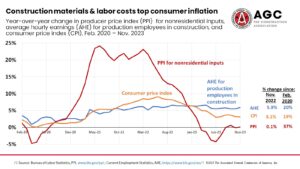
Input prices and bid prices for construction were little changed in November from October or year over year from November 2022, according to Associated General Contractors of America’s (AGC) analysis data from the U.S. Bureau of Labor Statistics. The producer price index (PPI) for material and service inputs to new nonresidential construction declined 0.2 percent, not seasonally adjusted, for the month, and increased 0.1 percent year over year.
Despite the recent moderation, the cumulative change in the inputs PPI since February 2020 is 37 percent, nearly double the 19 percent increase in the consumer price index (CPI), the commonly cited measure of inflation. Most inputs had modest changes for the month and year over year, with a few exceptions: the PPI for ready-mixed concrete was up 0.2 percent and 9.4 percent, and cement was unchanged for the month but rose 8.3 percent year over year.
Notable declines included the PPIs for diesel fuel, up 0.9 percent for the month but down 30 percent year over year; lumber and plywood, -2 percent and -11 percent, respectively; truck transportation of freight, -0.6 percent and -8.7 percent year over year; and steel mill products, -1.5 percent and -8.4 percent.
The index for new nonresidential building construction—a measure of prices that contractors say they would bid to erect a fixed set of buildings—fell 0.2 percent for the month and rose just 0.3 percent year over year. Changes in PPIs for new, repair, and maintenance work by subcontractors were mixed: roofing contractors, up 0.1 percent and 9.1 percent; plumbing, -0.4 percent and 3.3 percent; electrical, 0.1 percent and 2.5 percent; and
concrete contractors, 0 percent and -1.3 percent.
Additionally, the U.S. population growth between July 1, 2022, and July 1, 2023, rose to 0.49 percent from 0.37 percent in the previous 12 months, the U.S. Census Bureau reported. A return of “U.S. migration…to pre-pandemic levels and a [nearly 9 percent] drop in deaths are driving the nation’s growth. [Although births declined,] fewer deaths paired with rebounding immigration resulted in the nation experiencing its largest population gain since 2018. [The South] accounted for 87 percent of the nation’s growth in 2023,” due largely to net domestic migration of 706,266 and net international migration of almost 500,000. Of the record
19 states with decreases in 2022, 11 switched to gains and the rest had smaller declines in 2023, while growth accelerated in 16 states and the District of Columbia. Growth slowed in 13 states and was close to stable in South Carolina and Texas.
South Carolina grew the fastest (1.7 percent, 90,600 more residents), followed by Florida (1.6 percent, 365,205), which had been first in 2022. Texas added the most residents and was third in percentage growth (473,453, 1.6 percent). New York again had the largest numerical and percentage declines (-101,984, -0.5 percent). Population changes over time are a major contributor to demand for numerous types of construction, funding for public construction, and supply of potential construction workers.


